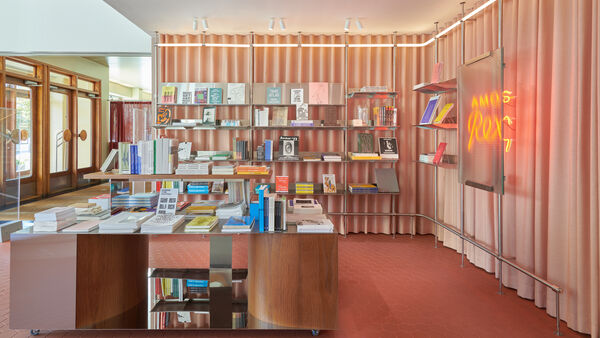Autism-friendly guidelines
This page is for everyone who would like more detailed information about visiting Amos Rex

This page describes what to expect on your museum visit at Amos Rex art museum. It’s meant for everyone who would like to get a little bit more information to prepare and plan for their visit. Where can you get your tickets, how do you enter and who do you meet? Read this before your visit.
The aim of the Autism Friendly certification is to make services more accessible to people with autism.
People on the autism spectrum can get past the queue at the barrier-free entrance. We recognise the Sunflower lanyard for example, which signals an invisible disability. The Sunflower lanyard allows visitors to discreetly let others know that they may need extra support or extra time. We cannot always guarantee immediate assistance, but we will do our best to make your museum visit a success!
At Amos Rex we often have many visitors at the same time. The most popular times to visit are weekends and special days, such as days with free entrance. On weekday mornings we sometimes have a lot of school groups. It is typically quieter on weekday afternoons and after 6pm.
Are you visiting us for the first time and have any questions about your visit after reading these pages? You can contact us at museum@amosrex.fi.
Choose a section to learn more
Welcome to Amos Rex! Amos Rex is an art museum. We present exhibitions focusing on modern and contemporary art, the exhibitions change regularly and vary a lot. If you have sensory defensiveness or sensitivity, we recommend you consider beforehand how much sensory load can you have during your visiting day at Amos Rex. You know your limits the best and these guidelines and our content remarks about the exhibition can help you to plan your visit in advance.
Location
The Amos Rex s located in central Helsinki in a building called Lasipalatsi (“Glass Palace”) on Mannerheimintie. The address is Mannerheimintie 22–24. The museum has two entrances: the main entrance on Mannerheimintie and the fully accessible entrance at the back of the building, on Lasipalatsi Square.
Arrival
For calmer and quieter visits, Amos Rex usually has the least visitors during weekday afternoons and weekday evenings after 6 pm. During the daytime and morning we have a lot of school groups visiting us.
We recommend booking tickets online in advance – including visitors with the Museum Card. That’s how you can skip any possible queuing at ticket sales and enter the museum without any hassle. If you have booked a ticket online, please arrive at the museum from the Lasipalatsi square side, through the accessible entrance.
If you have booked a ticket online, please arrive at the museum from the Lasipalatsi Square side, through the accessible entrance. There might be a queue at the main doors to enter if it’s a busy day. Online ticket lets you to skip the queues but please enter through the accessible entrance. Your online ticket is checked at the accessible entrance.
If you require to accessibility, you can always use the accessible entrance even without online tickets. The accessible entrance is also used by different guided tour groups, museum professionals with an ICOM card and people with a press card.
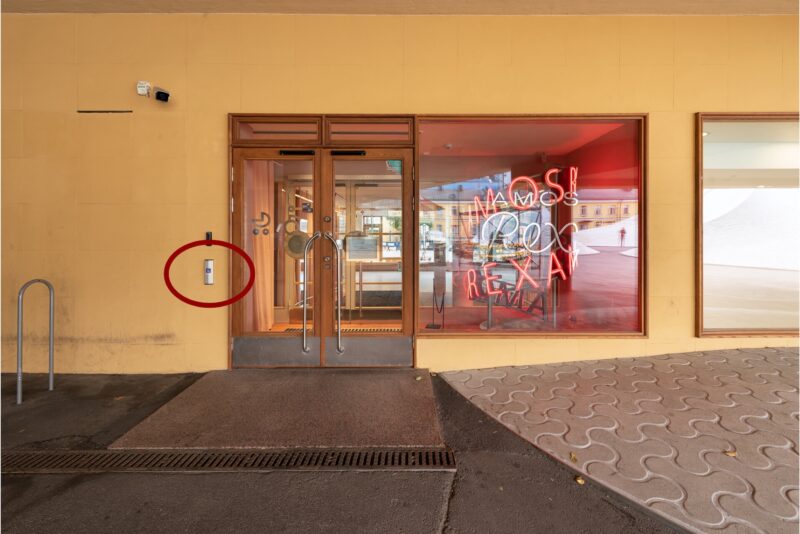
If you plan to buy a ticket when you arrive, use the main entrance on Mannerheimintie. The door is very heavy; you must pull hard to open it. There can be a queue of people waiting to buy tickets especially during the weekends, and then you might have to wait for some time to get in.
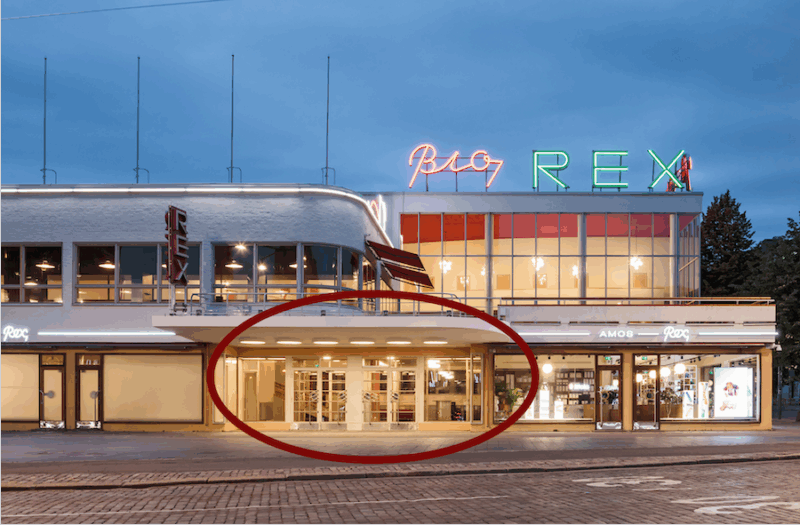
The museum has many staff members. You can identify them by their lilac jackets or black T-shirts that say Amos Rex on them. They also have name tags and small flags in the tags show what languages the person speaks. There is staff in the exhibition spaces and the lower lobby. The staff is happy to help you. They may also approach you to say hello and tell you about the exhibition. If you have any questions, or if you want to know more about the museum, you can always ask the staff. You can ask practically anything, such as where the toilets are, how much art is on show, or information about the artist.
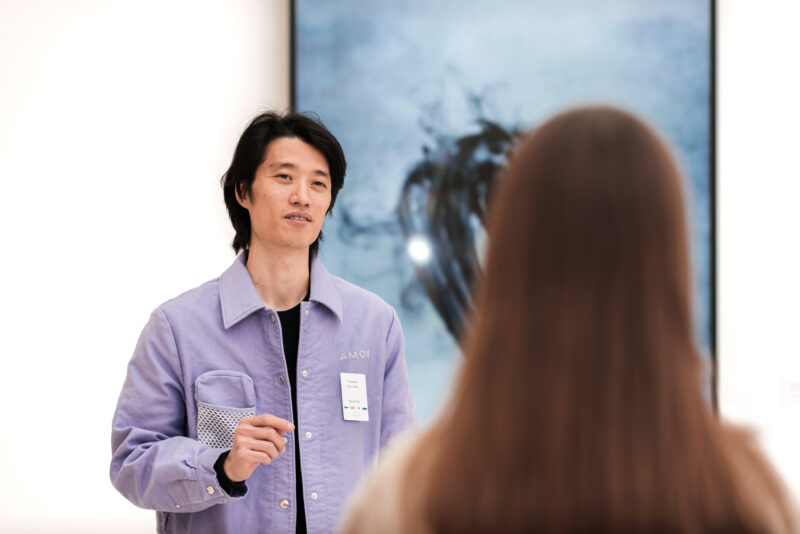
You don’t have to understand the art, and you don’t have to like everything. All questions and reactions are welcome!
There are also security guards in the exhibition area whose uniforms say Securitas. They are in the museum to make sure that both the artworks and people are safe.
You can ask any staff member or guard for advice, and they will offer help and guide you.
You can buy your admission ticket in advance online or on site at the museum.
The entrance for online tickets is on Kamppi’s side of the Lasipalatsi building. Please use the museum’s accessible door on the Lasipalatsi square’s side. Your ticket will be scanned in the museum shop Amos Rex Shop.
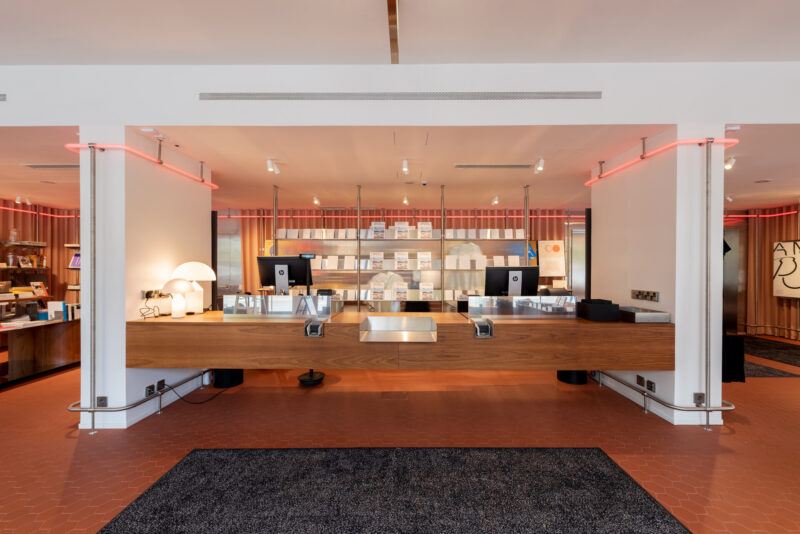
Tickets are also sold in the on-site in the lobby of Amos Rex at street level. Entrance is through the main doors on Mannerheimintie. You will find the cashier desk on the left of the main entrance.
Ask the cashier at the desk what kind of ticket you should buy for the exhibition. Tell them if you have a museum card or if you belong to a discount group, such as if you are under 18. Ticket prices can be found here and on a display at the front desk in the museum.
The admissions desk accepts debit and credit cards, cash and cultural vouchers.
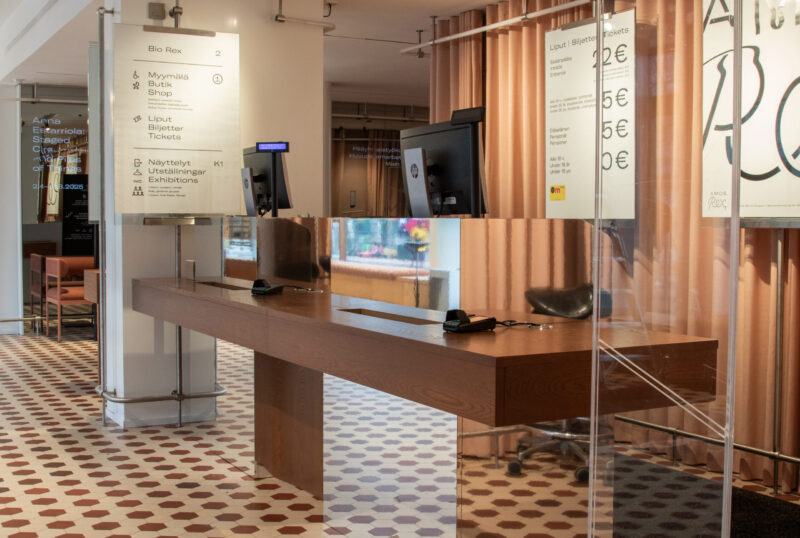
You can always check with your phone or tablet if online tickets are available while you’re waiting in line! With an online ticket, you can use the accessible entrance at the Lasipalatsi square. Exchange your online ticket for an admission sticker at the online ticket checkpoint or at the cash desk of the Amos Rex Shop museum shop.
When you have shown a pre-purchased ticket at the checkpoint or bought a ticket by queuing at the ticket office, you will receive a sticker from the staff. Attach this entry sticker, for example, to your shirt in a visible place, for example on the back of your hand or the front of your clothes. Keep the sticker visible throughout the visit. When you leave the museum, you can keep the sticker as a souvenir, throw it in the trash, or stick it on a wall at each entrance that already has a lot of stickers.
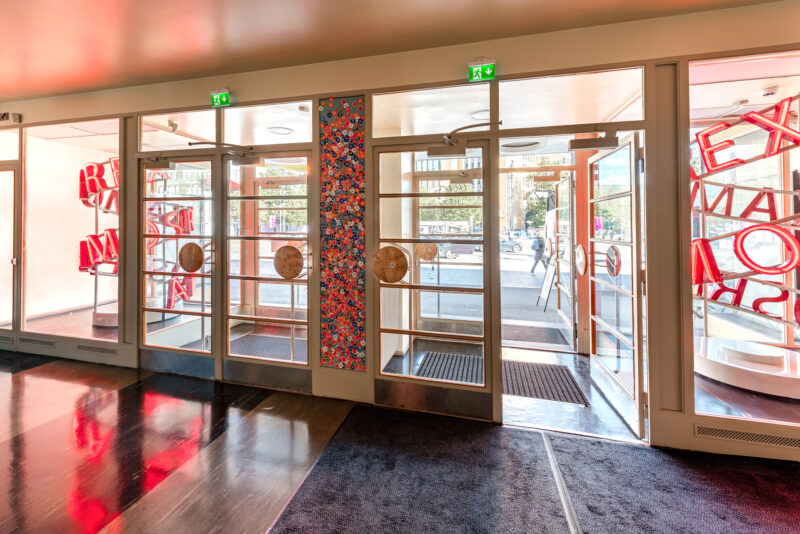
The exhibition spaces are located underground. Once you have your admission sticker, proceed downstairs or take the lift.
The stairs are located in the middle of the museum shop. The stairs are quite steep and brightly lit and white all over. There is a handrail on either side of the staircase but no central handrail.
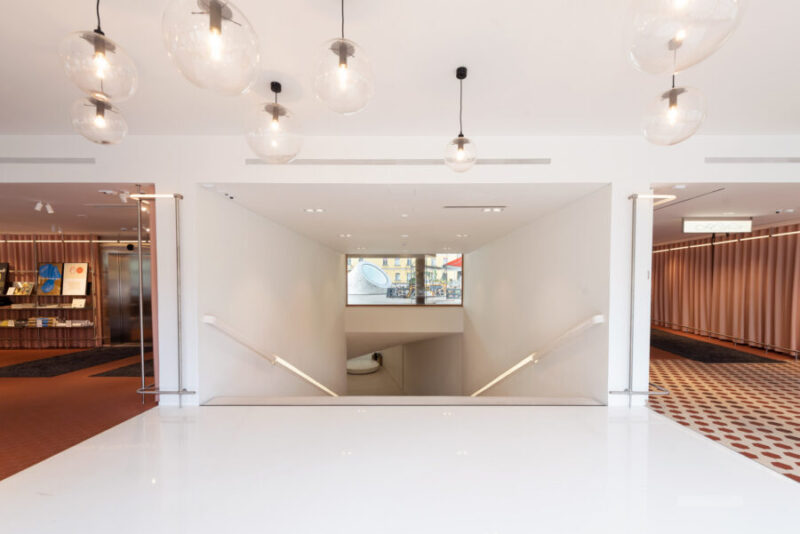
The lifts are located next to the stairs, on the left side. The exhibition spaces are located on floor -1. Next to the button in the lift it says Exhibition.
The walls of the lift are lighted. They are made of transparent material, and there are different coloured lights behind the walls. The lights move, but they do not flicker. There is also a quiet soundscape in the lift.
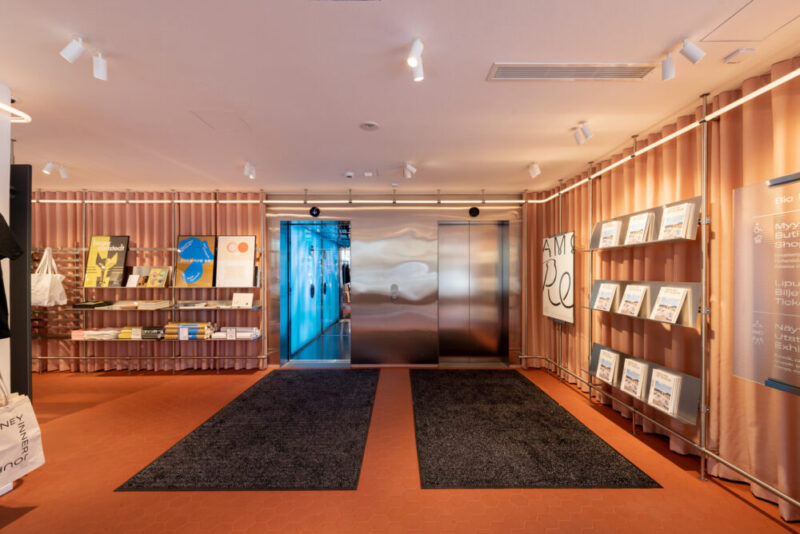
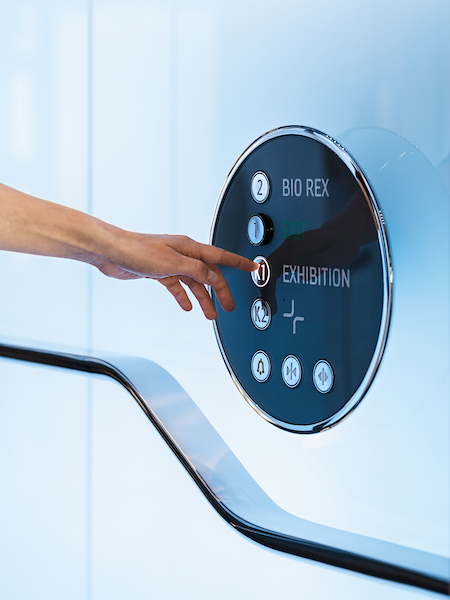
The main museum lobby is downstairs. From here, you enter the exhibition spaces. The lobby is white and brightly lit. The lobby is painted bright white while the toilet-cloakroom area is dark. Lightning is bright and a large skylight window lets the sunlight in. The space can cause some sensory load for people who have sensory sensitivities.
Cloakroom
There are free lockers in the lobby, as well as coat hooks where you can leave your coats and jackets and other items. The lockers are located in the part of the lobby that is black.
The museum has hearing protectors, wheelchairs, walkers, strollers, folding chairs, writing tablets and magnifying glasses for visitors’ use. Ask the staff if you need to borrow any of these items for your visit.
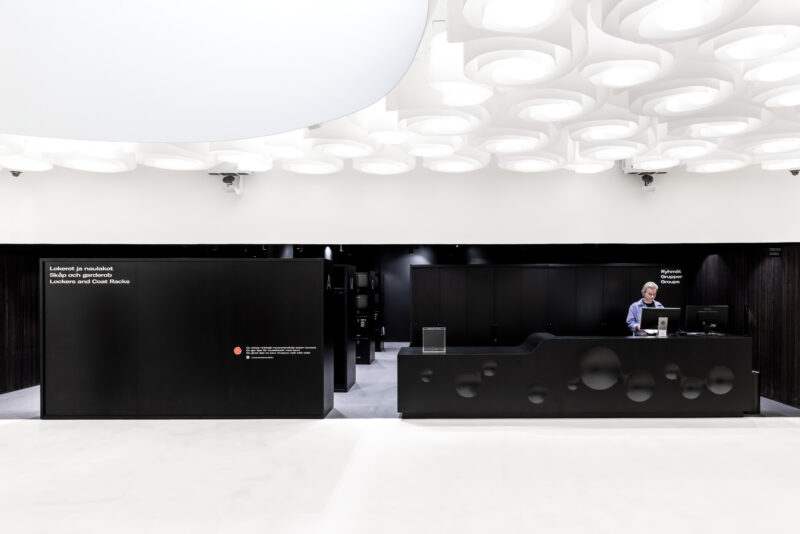
Each occupied locker emits a small, flashing, red light. Choose a vacant locker, place your things inside, and lock the door.
To lock the door of your locker, follow these steps: 1. Close the door of your locker. 2. Enter four numbers of your choice. 3. Finally, press the key with the green arrow in the bottom right corner. Check that the door is locked securely.
Important! Memorize the four-digit code you used. The same code will open the locker again. You open the locker the same way you locked it. If you press the wrong key, simply press C and start over. Also, remember the number of your locker so that you can locate it later.
Toilets
The toilets are located in the same area as the lockers. The toilets are divided into two separate areas. They are not divided by gender, and anyone can use any toilet. There are several small toilet cubicles on both sides.
At the back of each side is an accessible toilet that is suitable for wheelchair users. These accessible toilets are also a good place to take a break if you are experiencing sensory overload during your visit.
All functions in the toilets, from flushing to hand washing, are motion-activated. They work by waving your hand in front of the item you want to use. The toilets do not have air hand dryers.
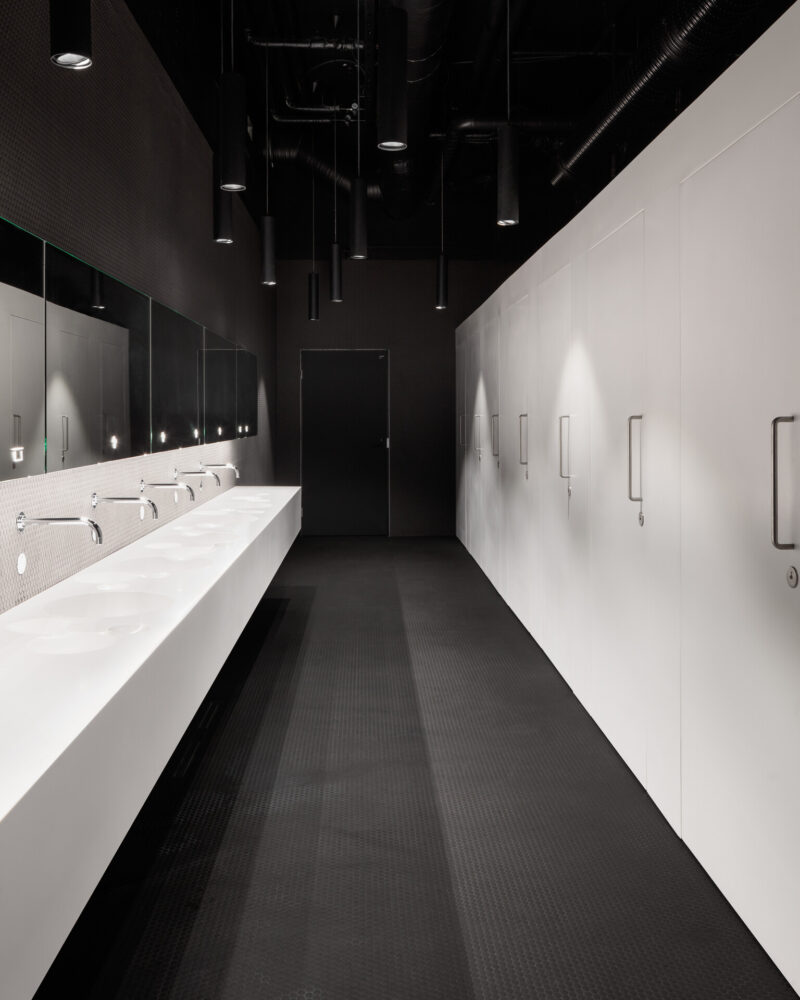
Baby changing room and strollers
Baby changing room and strollers
The baby changing room is located in the same area as the lockers. The door is located on the black wall with slats, to the right of the doorway leading to the toilets. The baby changing room has a changing table, hand shower, and potty.
Baby strollers can be left along the back wall of the locker area during your visit. There is a small stroller icon on the wall in the storage area. Please note that no prams or strollers may be left in front of an emergency exit. You can also bring your stroller with you to the exhibition, but leave any large items in the lockers or storage area. The museum also has strollers that you can borrow. Our staff are happy to help.
Entrance to the exhibition
Entrance to the exhibition is through the sliding doors located in the white lobby. There are staff members at the door: they will check your admission sticker. They will also advise you if you have any items that you should leave in the cloakroom before you enter the exhibition.
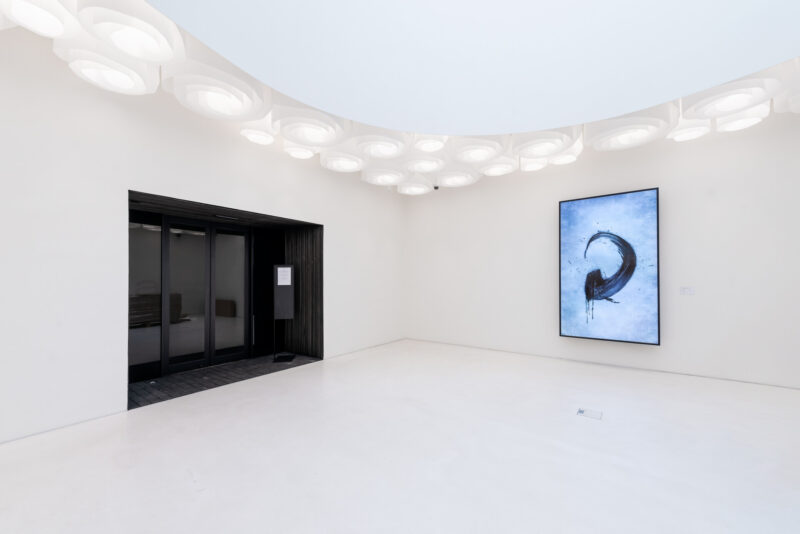
Staff members, located by the door, are happy to advise you about anything at the museum. A member of Amos Rex personnel will also check your entrance sticker. Amos Rex personnel wear lilac coats and black shirts.
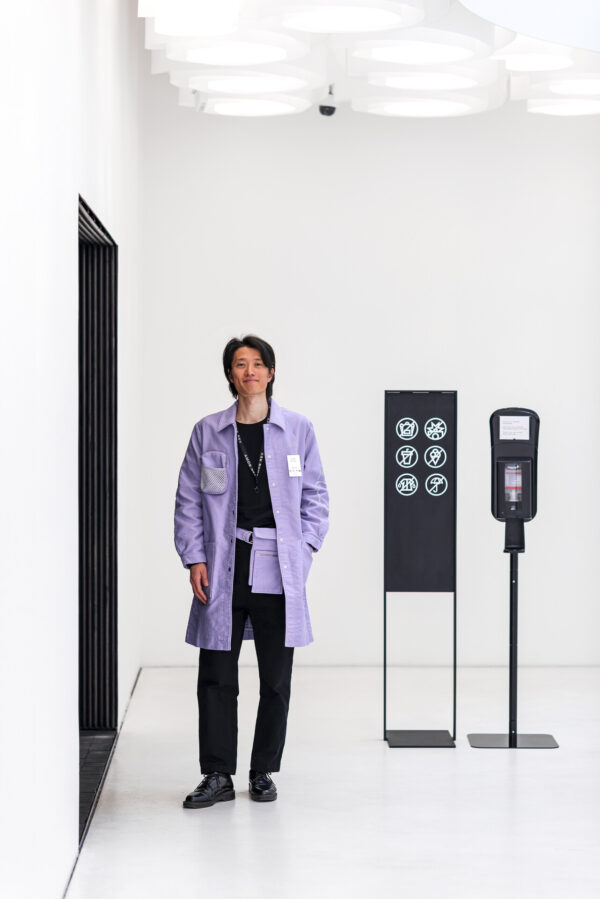
Museum rules
Check the museum rules on what items you can or cannot bring along with you to the exhibition space.
The museum’s basic rules are as follows:
- You may not eat or drink on the exhibition premises. Drink bottles and other liquids or snacks should be left in the self-service cloakroom or a locker.
- Backpacks and large bags must be left in a locker, as well as umbrellas on rainy days. You may take a smaller backpack to the exhibition if you carry it on your front or in your hand.
- Works of art and exhibition structures may not be touched, unless you are specifically instructed to do so by a sign or the staff.
- You may take photos and videos of the works in the exhibitions, as long as you do not use a flash and are considerate of other visitors.
- If you visit the exhibition with a small child or children, please hold them by hand while walking through the exhibition space.
Someone from the staff may approach you and tell you if you have any items or things that you are not allowed to take to the exhibition. It is okay if you don’t remember to leave everything on the list in the cloakroom – the staff are there to help you.
Gallery Guide
Next to the door, there is a stand with exhibition brochures. It has more information about the artworks and a map of the exhibition. There are brochures in Finnish, Swedish and English. The brochure is free of charge and you can take it with you or leave it to be recycled. The recycling box is a transparent plastic cube. It is located at the end of the cloakroom counter.
Exhibition hall floor
The floor in the exhibition spaces is made of wooden blocks, which makes the surface slightly uneven. The purpose of the wooden floor is to make the acoustics better and the floor softer to stand on for long periods of time. There are also some metallic floor tiles that can make a clank -sound when you step on them.
The quietest and calmest spaces at the museum are the accessible toilets in the underground lobby. There are two of them both at the end of each toilet corridor. The accessible toilets have full length doors that lock and they block some of the noise. The space is also a separate room in itself. Lighting is dimmer than elsewhere, the walls are dark.
Anyone from our staff can help you to exit the exhibition space and guide you to the accessible toilets. You can always ask for help or advice on site if you feel like it or need to.
The exhibition at Amos Rex changes about two times a year. For more information about the exhibitions, click here.
Leandro Erlich
In this exhibition Amos Rex features the large-scale, participatory installations of artist Leandro Erlich (b. in 1973 in Buenos Aires, Argentina). These installations blur our perceptions of reality. In the playful world of the artist, the laws of physics do not apply and familiar spaces and situations soon feel unreal. Playing with architecture, gravity and perspective, the works are bursting with visual and sensory illusions. Viewers who have entered this world can no longer trust what they see.
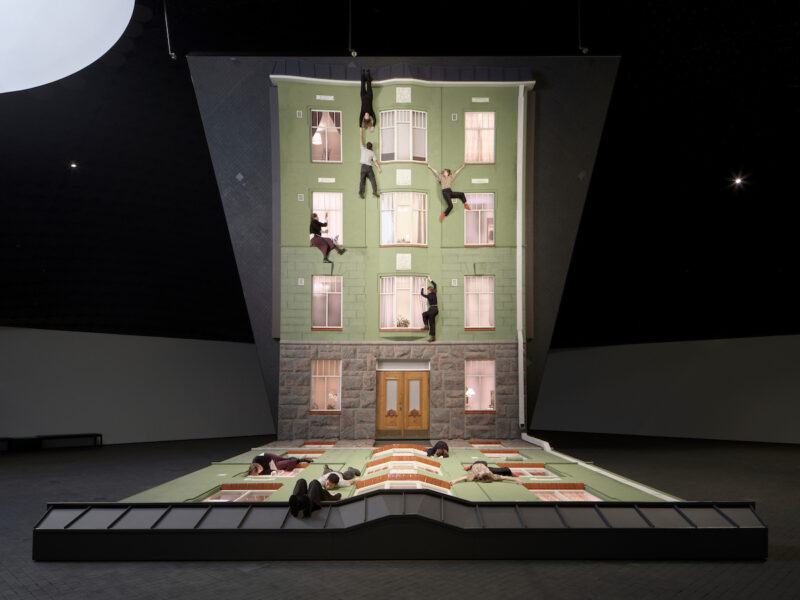
Erlich’s work has been featured in many leading art museums and exhibitions the world over, such as the Palais de Tokyo in Paris, the Barbican Centre in London, the MoMa in New York and the Museo de Arte Moderno in Buenos Aires. Erlich’s breakthrough took place at the Venice Biennale in 2001 with one of his most iconic installations, Swimming Pool.
This is the first time Erlich’s production has been on display in Finland. The curators are Anastasia Isakova and Kai Kartio.
Find out more about the content and sensory impact of the artworks here.
Sigurd Frosterus Collection
In addition to the current exhibition, the museum has a display with pieces from our permanent collection. It is marked on the map as the Sigurd Frosterus Collection. The collection display consists of paintings hung on the wall. The artworks do not include any sound or moving image.
The lighting in the space is rather bright. The air conditioning creates a rather distinguishable humming sound. There are also benches where you can sit and relax in peace and quiet.
There may be guided groups in the Sigurd Frosterus exhibition hall, which means that the space gets more noisy at times.
You can spend as much time there as you like. Exit the museum through the same entrances that are described above. Before leaving, remember to collect your belongings from your locker or the self-service cloakroom and to return any equipment you may have borrowed.
The museum has a shop, which is located at street level. If you want to buy something, you can pay for your purchase at the register. There are several ways out of the shop: either through an accessible door leading to Lasipalatsi Square or through the small door on Mannerheimintie.
